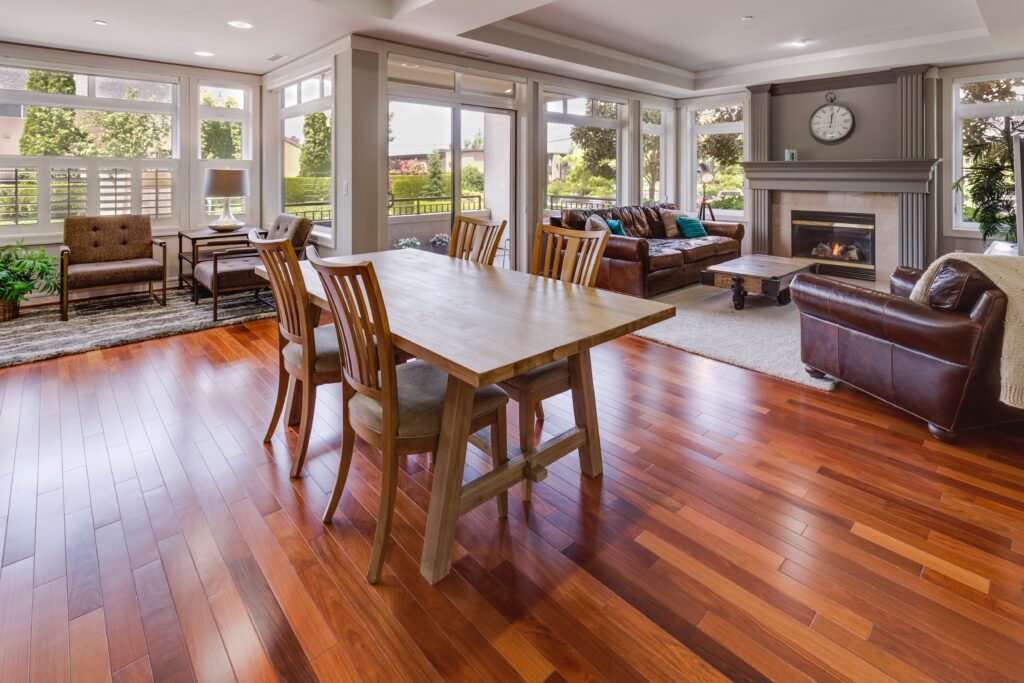If you need new flooring, you probably don’t know where to begin. Nowadays, there are so many choices thanks to the Internet. Well, something you do have to think about is the colour and texture of your flooring. Of course, you want a material that looks good, but you also have to think about how it makes you feel. Indeed, colours and textures can play a part in psychology and have the ability to affect your mood. Here’s a guide that can get you started so you can select the best flooring for your home.

Understanding Colour Psychology in Flooring
When it comes to flooring, colour is more than just a visual choice; it’s a powerful tool for setting the mood. Let’s take a look at how different colours influence our emotions:
Warm Colours:
Warm colours like red and orange are known for their energising and inviting properties. They create a cosy and lively atmosphere, making them perfect for spaces where you want to encourage social interactions. What’s more, in the winter, warm colours can help to add some heat to a room.
Cool Colours:
Cool colours like blue and green evoke feelings of calm and relaxation. They’re ideal for bedrooms or areas where you want to create a serene and peaceful ambiance. If you have a very hot room in the house, cool colours can also make sure it feels more comfortable.
Neutral Colours
Neutral colours like beige and Gray offer versatility. They can serve as a canvas for various design styles and adapt easily to different moods and aesthetics. They’re always on-trend, which allows you to feel good about your home. Check out the rigid core vinyl flooring available at Flooring Hut. You’ll see many interesting colours you can choose from for your home, no matter what style you’re going for.
The Influence of Texture on Emotional Response
Beyond colour, texture plays a significant role in how we perceive a space. Consider the following textures and their emotional impact.
Plush Carpets and Soft Rugs:
These flooring options offer a sense of comfort and cosiness. Perfect for creating a warm and inviting feel in living rooms and bedrooms. Plus, they feel nice underfoot and can make you feel at ease and relaxed.
Smooth and Polished Surfaces:
Smooth, polished floors like hardwood or tile exude a modern and clean aesthetic. They are great for spaces where a sleek and minimalistic look is desired. They can also look cleaner with minimal effort.
Textured Flooring Options:
Textured surfaces, such as natural stone or textured vinyl, provide tactile interest. They add depth and character to a room, making them suitable for areas where you want to create visual intrigue. They can also offer some grip underfoot.
Mood and Room Selection
Now that you understand the basics of colour and texture psychology, let’s delve into practical applications. How can you choose the right flooring to create specific moods in different rooms of your home?
The Living Room:
Consider warm, earthy tones and soft textures to promote relaxation and conversation. This is often the main room in the home where you want to unwind after a long day. Your design can help you do this.
The Home Office:
Opt for energising colours and smooth textures to boost productivity and focus. This is where you want to be your sharpest and get work done.
The Bedroom:
Choose cool, calming colours and plush textures to create a tranquil sanctuary for restful sleep. You want to feel relaxed here and ready for a good night’s rest.
Case Studies and Examples
To give you a better sense of how flooring choices can transform a space, let’s look at a few real-life examples:
Cosy Living Room Makeover:
You can transform a dull living room with warm-toned hardwood flooring and a soft, plush area rug. The result? A welcoming space perfect for family gatherings.
Modern Home Office Revamp:
By installing sleek, dark tile flooring in a home office, you can turn a cluttered room into a professional and productive workspace.
Serene Bedroom Retreat:
With the addition of cool blue carpeting and textured curtains, a master bedroom can become an oasis of tranquility.
These examples demonstrate how the psychology of flooring can be applied to achieve specific design goals.
Practical Tips for Flooring Selection
Ready to make informed flooring choices? Here are some practical tips:
Consider Lighting:
Natural and artificial lighting can influence how flooring colours appear. Test samples in different lighting conditions to see what they really look like.
Room Size Matters:
Lighter flooring can make small rooms feel more spacious, while darker options can add cosiness to larger areas.
Existing Decor:
Your flooring should complement your existing furniture and decor—Harmonise colours and styles for a cohesive look.
Maintenance and Longevity
While aesthetics are important, don’t forget to consider practicality. High-maintenance flooring may not be suitable for a busy household, so choose options that align with your lifestyle and cleaning preferences. Indeed, if you work a lot, you want something that’s low maintenance. If you have children or pets, you need flooring that’s durable and easy to clean. Always ensure the flooring is functional for the lifestyle you have before purchasing it.
Conclusion
In the world of interior design, flooring is a silent but powerful player. Its colours and textures wield the ability to shape moods, evoke emotions, and transform spaces. By understanding the psychology of flooring, you can embark on a design adventure that not only beautifies your home but also enhances your quality of life.